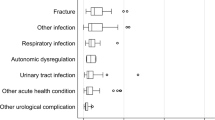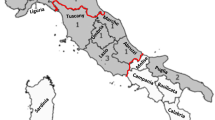Abstract
Study Design: Retrospective cohort study.
Objective: To monitor length of stay (LOS) in a specialist spinal cord lesion (SCL) department in Israel, evaluate factors that affect it, and assess its association with other outcome measures.
Setting: Loewenstein Rehabilitation Hospital, Raanana, Israel.
Methods: In all, 1367 SCL patients treated between 1962 and 2000, and a group of 44 patients admitted between 1996 and 2002 were recruited. LOS, factors that affect it, and Spinal Cord Independence Measure second version (SCIM-II) gain and efficiency were measured. Data were collected from hospital charts and from the Population Registry of the Israel Ministry of Internal Affairs. LOS associations were analyzed with ANOVA, ANCOVA, Pearson's χ2 test, Pearson's correlation, and Cox proportional hazard model.
Results: The mean LOS was 239 days for traumatic SCL (SD=168) and 106 days for non-traumatic SCL (SD=137). SCL etiology, SCL severity, and decade of admission to rehabilitation, were associated with the LOS (P<0.001). SCIM II gain correlated with LOS in the first 70 days after admission (r=0.81–0.82; P<0.001). In some patients, longer LOS was associated with a considerable increase in ability, through 5–8 months from admission.
Conclusions: LOS of patients with SCL in Israel is within the customary LOS range in Europe. Longer LOS in a specialist SCL department may be positively associated with improved rehabilitation outcome. Further study is required to determine the LOS that allows optimal achievements.
Similar content being viewed by others
Log in or create a free account to read this content
Gain free access to this article, as well as selected content from this journal and more on nature.com
or
References
van der Putten JJ, Stevenson VL, Playford ED, Thompson AJ . Factors affecting functional outcomes in patients with nontraumatic spinal cord lesions after inpatient rehabilitation. Neurorehabil Neural Repair 2001; 15: 99–104.
McKinley WO, Tewksbury MA, Mujteba NM . Spinal stenosis vs traumatic spinal cord injury: a rehabilitation outcome comparison. Spinal Cord Med 2002; 25: 28–32.
McKinley WO, Seel RT, Gadi RK, Tewksbury MA . Nontraumatic vs. traumatic spinal cord injury: a rehabilitation outcome comparison. Am J Phys Med Rehabil 2001; 80: 693–699.
New PW, Rawicki HB, Bailey MJ . Nontraumatic spinal cord injury: demographic characteristics and complications. Arch Phys Med Rehabil 2002; 83: 996–1001.
Burnett DM, Kolakowsky-Hayner SA, Gourley EV, Cifu DX . Spinal cord injury ‘outliers’: an analysis of etiology, outcomes, and length of stay. J Neurotrauma 2000; 17: 765–772.
Celani MG, Spizzichino L, Ricci S, Zampolini M, Franceschini M . Spinal cord injury in Italy: a multicenter retrospective study. Arch Phys Med Rehabil 2001; 82: 589–596.
Seel RT, Huang ME, Cifu DX, Kolakowsky-Hayner SA, McKinley WO . Age-related differences in length of stay, hospitalization cost and outcomes for an injury-matched sample of adults with paraplegia. J Spinal Cord Med 2001; 24: 241–250.
DeVivo MJ, Krause JS, Lammertse DP . Recent trends in mortality and cause of death among persons with spinal cord injury. Arch Phys Med Rehabil 1999; 80: 1411–1419.
Eastwood EA, Hagglund KJ, Ragnarsson KT, Gordon WA, Marino RJ . Medical rehabilitation length of stay and outcomes for persons with traumatic spinal cord injury. Arch Phys Med Rehabil 1999; 80: 1457–1463.
Berkowitz M, O'Leary PK, Kruse DL, Harvey C . Spinal Cord Injury: An Analysis of Medical and Social Costs. Demos: New York, 1998, pp 38–72.
Sconherr MC, Groothoff JW, Mulder GA, Eisma WH . Rehabilitation of patients with spinal cord lesions in The Netherlands: an epidemiological study. Spinal Cord 1996; 34: 679–683.
Hoque MF, Grangeon C, Reed K . Spinal cord lesions in Bangladesh: an epidemiological study 1994–1995. Spinal Cord 1999; 37: 858–861.
Bravo P, Labarta C, Alcaraz MA, Mendoza J, Verdu A . Outcome after vertebral fractures with neurological lesions treated either surgically or conservatively in Spain. Paraplegia 1993; 31: 358–366.
Biering-Sorensen E, Pedersen V, Clausen S . Epidemiology of spinal cord lesions in Denmark. Paraplegia 1990; 28: 105–118.
Dawson-Saunders B, Trapp RG . Basic and Clinical Biostatistics. Appleton and Lange: Norwalk, CT, 1994.
Frankel, Hancock DO, Hyslop G, Melzak J, Michaelis LS, Ungar GH et al. The value of postural reduction in the initial management of closed injuries of the spine with paraplegia and tetraplegia. Paraplegia 1969; 24: 179–192.
Itzkovich M, Tripolski M, Zeilig G, Ring H, Rosentul N, Ronen J, Spasser R, Gepstein R, Catz A . Rasch analysis of the Catz–Itzkovich spinal cord independence measure. Spinal Cord 2002; 40: 396–407.
Smith M . Efficacy of specialist versus non-specialist management of spinal cord injury within the UK. Spinal Cord 2002; 40: 10–16.
Acknowledgements
We express our special gratitude to Dr L Mendelson, Medical Director of Spinal Rehabilitation at Loewenstein Hospital until 1992. This study was supported by the Unit of Medical Services, Rehabilitation Department, Israel Ministry of Defense.
Author information
Authors and Affiliations
Rights and permissions
About this article
Cite this article
Ronen, J., Itzkovich, M., Bluvshtein, V. et al. Length of stay in hospital following spinal cord lesions in Israel. Spinal Cord 42, 353–358 (2004). https://doi.org/10.1038/sj.sc.3101590
Published:
Issue date:
DOI: https://doi.org/10.1038/sj.sc.3101590
Keywords
This article is cited by
-
Rehabilitation length of stay and functional improvement among patients with traumatic spinal cord injury
Spinal Cord (2022)
-
Spinal cord injury rehabilitation in Riyadh, Saudi Arabia: time to rehabilitation admission, length of stay and functional independence
Spinal Cord (2017)
-
Impact of benchmarking and clinical decision making tools on rehabilitation length of stay following spinal cord injury
Spinal Cord (2013)
-
Epidemiology of traumatic cervical spinal cord injury in Tianjin, China
Spinal Cord (2012)
-
SCIM III is reliable and valid in a separate analysis for traumatic spinal cord lesions
Spinal Cord (2011)



